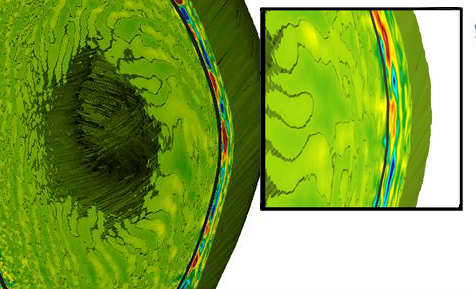 When the DOE’s pre-exascale supercomputers come online soon, all three will be running an optimized version of the XGC dynamic fusion code. Developed by a team at the DOE’s Princeton Plasma Physics Laboratory (PPPL), the XGC code was one of only three codes out of more than 30 science and engineering programs selected to participate in Early Science programs on all three new supercomputers, which will serve as forerunners for even more powerful exascale machines that are to begin operating in the United States in the early 2020s.
When the DOE’s pre-exascale supercomputers come online soon, all three will be running an optimized version of the XGC dynamic fusion code. Developed by a team at the DOE’s Princeton Plasma Physics Laboratory (PPPL), the XGC code was one of only three codes out of more than 30 science and engineering programs selected to participate in Early Science programs on all three new supercomputers, which will serve as forerunners for even more powerful exascale machines that are to begin operating in the United States in the early 2020s.
The PPPL code, called XGC, simulates behavior of the ions, electrons and neutral atoms in the transport barrier region– or “pedestal” — between the ultra-hot core of the plasma that fuels fusion reactions and the cooler and turbulent outer edge of the plasma. The pedestal must be high and wide enough to prevent damage to the divertor plate that exhausts heat in doughnut-shaped tokamaks that house the fusion reactions.
“How to create a high edge pedestal without damaging the divertor wall is the key question to be answered,” said lead physicist C.S. Chang. “That is a prerequisite for achieving steady state fusion.”
Selection of the PPPL code could help ready it for exascale development. “Computer architecture is evolving rapidly and these new pre-exascale computers have features that are quite different from some of the earlier petascale supercomputers,” said Amitava Bhattacharjee, head of the Theory Department at PPPL. Petascale machines operate in petaflops, or one million billion (1015) floating point operations per second. Bhattacharjee heads a PPPL-led Exascale Computing Project that will integrate the XGC code with GENE, a code developed at the University of California, Los Angeles, to create the first simulation of a complete fusion plasma. Exascale supercomputers will perform exaflops, or a billion billion (1018) floating point operations per second.
The XGC code will be optimized on the following pre-exascale supercomputers:
- Cori, now fully installed at the National Energy Research Scientific Computing Center (NERSC) at the Lawrence Berkeley National Laboratory. Cori, named for biochemist Gerty Cori, the first American woman to win a Nobel Prize in science, has a theoretical peak speed of 30 petaflops per second on scientific applications using Intel Xeon “Haswell” and Xeon Phi “Knights Landing” processor nodes.
- Also selected to participate in Cori’s NERSC Exascale Science Applications Program (NESAP) is the PPPL-led M3D-CI, an extended magnetohydrodynamics (MHD) code focused on simulation of plasma disruptions led by physicist Stephen Jardin, with support from physicists Joshua Breslau, Nate Ferraro and Jin Chen.
- Two more PPPL-led codes, in addition to the 20 that included XGC and M3D-CI that were previously selected, will participate in the Cori NERSC program. These programs are GTC-P and GTS codes that model plasma turbulence in the plasma core and are headed by physicists William Tang and Stephane Ethier. Principal developer of the GTS code is PPPL physicist Weixing Wang. The GTC-P code is PPPL’s version of the GTC code led by the University of California, Irvine.
- Summit, to be operational at the Oak Ridge Leadership Computing Facility at Oak Ridge National Laboratory in 2018. Summit features a hybrid architecture consisting of IBM Power 9 processors and multiple NVIDIA Volta graphic processing units and will be capable of performing up to at least 200 petaflops for a wide range of applications. The facility’s Center for Accelerated Application Readiness (CAAR) program has selected 13 projects that will participate in the program to optimize their applications codes and demonstrate the effectiveness of their applications on Summit.
- Aurora, scheduled to be deployed in 2018 at the Argonne Leadership Computing Facility (ALCF) at Argonne National Laboratory, will be comprised of third generation Intel Xeon Phi “Knights Hill” many-core processors. Ten projects have been selected for the ALCF Early Science Program, which is expected to be capable of performing up to 200 petaflops on a wide range of scientific applications.
PPPL, on Princeton University’s Forrestal Campus in Plainsboro, N.J., is devoted to creating new knowledge about the physics of plasmas — ultra-hot, charged gases — and to developing practical solutions for the creation of fusion energy. The Laboratory is managed by the University for the U.S. Department of Energy’s Office of Science, which is the largest single supporter of basic research in the physical sciences in the United States, and is working to address some of the most pressing challenges of our time.



